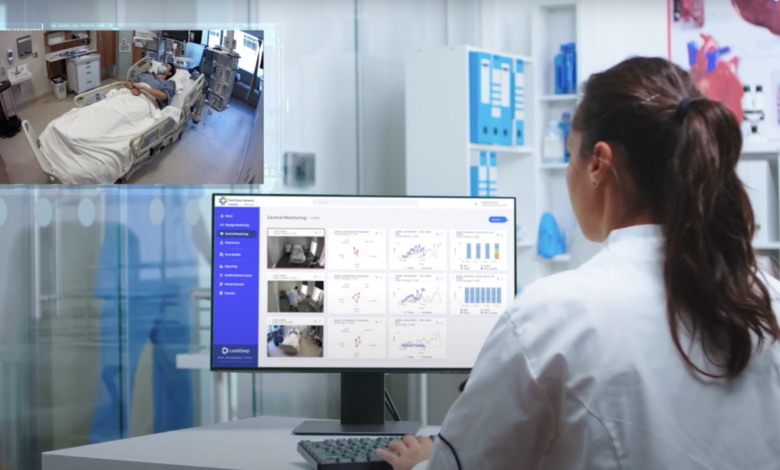
According to the Emergency Care Research Institute (ECRI), care coordination challenges and proper timing for interventions are just a few of the top issues for patient and provider safety. Combined with an ongoing nursing shortage, these concerns put even more pressure on overworked clinicians. Furthermore, these challenges require innovation that fits into the limited financial and staffing constraints of the hospital.
Because clinicians cannot be in a patient’s room all the time, hospitals can benefit from utilizing powerful AI video monitoring that can. For example, through computer vision, AI can identify patient movement patterns and prompt clinical workflow that address take action (e.g. pressure risk, getting out of bed without help, etc.). More generally, hospitals can use these kinds of AI insights to increase their understanding of patients, alleviate staff workload related to events outside the patient’s presence and boost overall operational efficiencies.
Rather than starting with a black box prediction of a condition (e.g. patient has delirium), computer vision AI that generates observations (patient is restless in bed during the night and lethargic in the morning) will be more easily accepted because they can be easily understood and validated. This leads to AI as a trusted resource, which can reduce fear of the unknown among clinicians and aid adoption.
At the same time, and at this stage, AI cannot stand alone. Like full self driving in cars, it will take years to make observational AI autonomous in situations as potentially fraught with risk as hospital care. Yet AI plus humans can deploy the breadth and speed of AI observation with the context and knowledge of experts to impact care and cost today.
Observing, identifying and taking action: The synergy of humans and AI in enhancing patient safety
ECRI’s safety concerns demonstrate several core themes: timely intervention is key; clinical support is critical; and care coordination must be efficient. In their absence, patient safety is compromised, resulting in insufficient care and potentially leading to harm. Therefore, AI becomes a critical tool to support clinicians making swift decisions. AI supplemented by virtual providers can improve efficiencies and keep patients and their care teams safe.
The virtual caregiver supports the bedside team
Early in their careers, doctors and nurses often find themselves tasked with responsibilities that exceed their skillsets or professional training, which we know leads to burnout. Coupled with current nursing shortages, nurses with less experience than their peers are being presented with situations that are becoming increasingly difficult for them to handle.
This is an optimal opportunity for assistance from an AI-powered virtual nursing system, especially at times when nurses are being asked to manage and maintain requirements for patients on each unit they serve. Virtual nurses can also function as a secondary verification mechanism; this can reduce medication errors and directly relates to three of ECRI’s safety concerns.
In addition, a senior virtual nurse can provide assistance for changing patient status or guidance for certain procedures. This can be on-demand from a bedside nurse or via the AI bringing attention to patients that have certain characteristics (in bed, not moving without any recent care activity). AI expands the reach of the virtual nurse by allowing it to be in the right place at the right time to help the bedside team.
Reducing patient violence toward clinicians
Predictive analysis and video monitoring enables AI to instantly identify aggression towards healthcare staff and minimize potential safety issues before they get worse. Further, in addition to video monitoring that tracks the patient’s movement over time, it notes changes in their behavioral patterns to identify increased acuity or risk levels. This enables clinicians to respond faster and reduce the chances of dangerous or violent situations. Enhanced with affordable, existing technology, clinicians can check on patients at any time and provide quicker response to a variety of abnormal situations.
Consequences of poor care coordination
There are significant consequences for patients with complex medical conditions who have gaps in their care. Admission to the ICU is one of them.
Continuous AI video monitoring tracks various important characteristics, including the patient’s movement, location, care activity and other trends, that can help to further that patient’s progress when moving to a lower acuity setting. Ultimately, this monitoring, coupled with virtual consultations, fosters improved care coordination between the teams where the patient is located and where the patient is going. It also helps patients who need critical care to receive it when necessary while allowing them to remain in a lower level of care inside or outside of the hospital.
The bottom line
While imperative, it’s also a formidable task to navigate patient safety concerns in our current healthcare landscape. However, the integration of AI and human expertise can positively address these challenges. In addition to strengthening care quality and patient safety, AI reduces the burden on healthcare staff, thus enhancing their professional well-being. As the healthcare sector continues to evolve, integrating AI will be crucial in addressing patient safety challenges and arriving at the best possible care outcomes.




